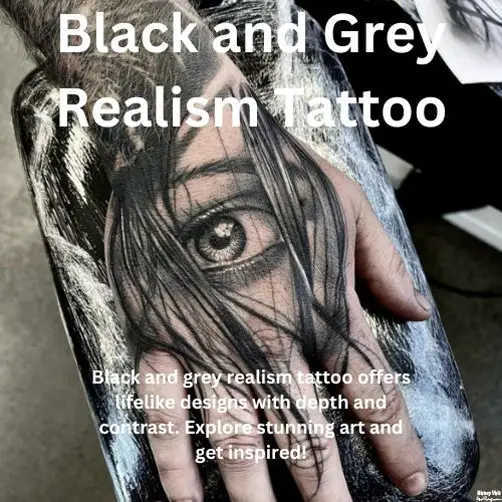Black and Grey Realism Tattoo: Stunning Art on Skin!

Introduction: The Allure of Black and Grey Realism Tattoo
Black and grey realism tattoo has become increasingly popular in recent years. This tattoo style offers a unique blend of artistry and technique. The use of shades and shadows creates lifelike images on the skin. This article explores the essence of black and grey realism tattoo art, its history, and key elements.
The introduction of black and grey realism tattoos revolutionized the tattoo industry. These tattoos require a high level of skill and precision. The focus on shading rather than color brings a different depth and realism. This technique allows for intricate details and a sophisticated aesthetic. The popularity of this style is due to its versatility and timeless appeal.
In this article, we will delve into the history, techniques, and considerations of black and grey realism tattoos. Whether you’re an aspiring tattoo artist or a tattoo enthusiast, understanding this style can enhance your appreciation. The journey begins with exploring the origins of this artistic tattoo form.
The History and Evolution of Black and Grey Realism Tattoo

Early Beginnings: The Origins of Black and Grey Tattoo
Black and grey realism tattoo art has roots tracing back to ancient cultures. Early tattoos were primarily black, using soot or charcoal. These early forms set the foundation for modern black and grey techniques. The use of shading began to evolve, enhancing the depth and realism of the designs.
The prison system in the United States played a significant role in the development of black and grey tattoos. Limited access to colored inks led inmates to innovate with black ink. They used varying shades to create depth and detail, giving rise to the “black and grey” style. This method became a symbol of prison culture and later influenced mainstream tattoo artistry.
As tattoo culture grew, black and grey realism tattoos gained prominence. Artists like Jack Rudy and Freddy Negrete popularized the style in the late 20th century. They refined techniques, bringing more realism and sophistication to the art form. Today, this style is celebrated for its ability to capture lifelike images and emotional depth.
Techniques in Black and Grey Realism Tattoo Art
Understanding Shading and Gradation
Shading is a critical component in black and grey realism tattoos. It involves creating gradients to depict light and shadow, adding depth to the artwork. The absence of color puts a greater emphasis on the precision of shading. Artists use different needle configurations to achieve various shading effects.
The technique requires a keen eye for detail and a steady hand. Gradation involves smoothly transitioning from dark to light shades. This creates a three-dimensional effect on the skin, making the tattoo appear more lifelike. Artists often practice on synthetic skin to perfect their shading techniques.
Different needle groupings are used for various effects. Liners and shaders are the two main types of needles in tattooing. Liners are used for creating outlines, while shaders are used for filling and shading. The choice of needle affects the texture and depth of the tattoo, making technique mastery crucial.
The Importance of Reference Images
Reference images are essential in black and grey realism tattooing. They serve as a blueprint for the artist to replicate on the skin. High-quality reference images allow for accurate detailing and realism. Artists often use photographs of people, animals, or objects as references.
The process involves translating a two-dimensional image into a three-dimensional tattoo. This requires not only technical skill but also an artistic vision. The artist must understand the anatomy and structure of the subject to capture its essence. This understanding helps in creating a more accurate and realistic representation.
Using reference images also helps in achieving consistency in the artwork. It ensures that the proportions and features are correctly replicated. Artists often make adjustments to the reference image to fit the tattoo’s placement on the body. This customization adds a unique touch to each piece of art.
Line Work and Detailing in Black and Grey Tattoos
Line work is the foundation of black and grey realism tattoos. It involves creating outlines and defining features. Clean, precise lines are crucial for maintaining the integrity of the design. The quality of line work sets the stage for the shading and detailing to follow.
Detailing brings the tattoo to life by adding intricate features and textures. This includes everything from the tiny wrinkles on a face to the fur on an animal. Detailing requires a high level of skill and patience. It is often the most time-consuming part of the tattooing process.
Attention to detail can make or break a black and grey realism tattoo. Even the smallest details can significantly impact the overall look. Artists often use fine needles and take their time to get the details just right. This meticulous approach ensures that the tattoo looks as realistic as possible.
Considerations for Getting a Black and Grey Realism Tattoo

Choosing the Right Artist for Your Tattoo
Selecting the right artist is crucial when getting a black and grey realism tattoo. This style requires a high level of skill and experience. Not all tattoo artists specialize in black and grey realism. Researching and finding an artist with a proven track record is essential.
Check the artist’s portfolio to see their previous work. Look for examples of black and grey realism tattoos they have done. Pay attention to the quality of shading, line work, and detail. A good artist should have a portfolio showcasing their expertise in this style.
Consultations are an important step in choosing the right artist. During the consultation, discuss your ideas and expectations. The artist can provide feedback and suggestions to enhance the design. This is also an opportunity to assess the artist’s professionalism and communication skills.
Preparing for Your Tattoo Session
Preparation is key to a successful tattoo session. Make sure you are well-rested and hydrated. Avoid alcohol and caffeine, as they can thin the blood and increase bleeding. Eating a good meal before the session helps maintain your energy levels.
Wear comfortable clothing that allows easy access to the tattoo area. Bring snacks and water to stay nourished and hydrated during the session. Some tattoos can take several hours, so being prepared is essential.
It’s also important to have a clear understanding of the design and placement. Discuss these details with the artist before the session. This ensures that there are no surprises on the day of the tattoo. Clear communication with the artist helps in achieving the desired outcome.
Aftercare Tips for Black and Grey Tattoos
Proper aftercare is crucial for the healing and longevity of your tattoo. Follow the artist’s instructions for aftercare. This usually includes keeping the tattoo clean and moisturized. Avoid exposing the tattoo to direct sunlight or soaking it in water.
It’s normal for the tattoo to peel and scab as it heals. Avoid picking at the scabs, as this can cause scarring. Use a gentle, fragrance-free moisturizer to keep the skin hydrated. Keeping the tattoo moisturized helps in the healing process and prevents itching.
Long-term care involves protecting the tattoo from the sun. UV rays can fade the ink and reduce the tattoo’s vibrancy. Use a high SPF sunscreen to protect your tattoo when exposed to the sun. Regular touch-ups can also help maintain the tattoo’s appearance over time.
Conclusion: The Timeless Appeal of Black and Grey Realism Tattoos
Black and grey realism tattoo offers a unique blend of artistry and technical skill. This style captures lifelike images with incredible detail. The use of shading and gradation adds depth and realism. It’s a style that has evolved over the years and continues to grow in popularity.
Whether you’re an artist or a tattoo enthusiast, understanding this style is essential. It requires a high level of skill and attention to detail. Choosing the right artist and preparing properly are crucial steps. Proper aftercare ensures that your tattoo heals well and looks great for years to come.
In conclusion, black and grey realism tattoos are a timeless art form. They offer a unique way to capture realistic images on the skin. This style’s versatility and sophistication make it a popular choice. Whether it’s a portrait, an animal, or a scene, black and grey realism tattoos are a masterpiece on the skin.


